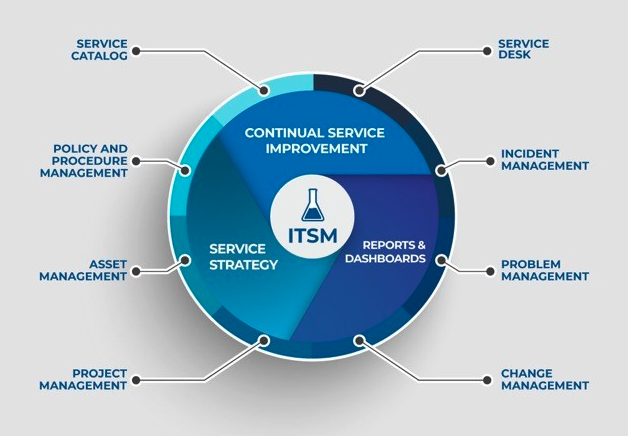
What is ITSM Process (Image by QPro)

What is ITSM Process (Image by QPro)
Well-structured IT service management process significantly contribute to the overall efficiency and effectiveness of IT services within an organization.
These processes encompass end-to-end management of IT services, from design and creation to delivery, support, and lifecycle management.
By focusing on defined, repeatable processes that address customer and business needs, ITSM ensures that IT services are operational and optimized for maximum effectiveness and efficiency.
LMTEQ conducted a case study on ServiceNow IT Service Management (ITSM) deployment, demonstrating the transformative power of well-structured ITSM processes.
The study involved a global software and support services leader that aimed to improve operational efficiency by automating key processes within its IT Service Desk.
The main goal was to automate the onboarding and offboarding processes for new team members, which previously relied on manual communication and were prone to delays and inefficiencies.
Implementing ServiceNow ITSM and custom applications significantly improved operational efficiency and user satisfaction by streamlining workflows and reducing the need for manual interventions.
This example highlights the significance of implementing structured ITSM processes to attain operational excellence.
Therefore, we present some details related to the ITSM process below.
IT Service Management (ITSM) processes are designed to ensure IT services meet your business needs and customer expectations. How? By focusing on delivering, managing, and improving IT services.
Therefore, ITSM integrates people, processes, and technology to facilitate effective service delivery and support.
As a result, some key components within the ITSM process structure are outlined below.
This involves planning and developing services based on customer needs, focusing on defining service-level agreements, managing capacity, and ensuring availability.
It includes risk management to guarantee business continuity and involves change management to oversee the life cycle of IT changes.
Once services are designed and transitioned, they are implemented in a live environment.
This stage addresses incident and request fulfillment management, ensuring that all IT incidents are resolved swiftly and service requests meet agreed-upon targets.
It also includes problem and technical management to minimize the impact of IT incidents and manage the IT infrastructure.
ITSM processes are dynamic, with continuous assessment for improvement based on customer feedback, performance metrics, and service reviews.
Key performance indicators (KPIs) and metrics are crucial for identifying improvement areas to enhance service delivery and customer satisfaction.
This lifecycle is structured around several stages, each focusing on specific aspects of service management to ensure efficiency, effectiveness, and continual improvement.
This initial stage establishes the direction for a more end-to-end IT Service Management system.
This phase focuses on defining a strategy that aligns IT services with your business objectives.
It involves understanding customer needs, market opportunities, and the financial viability of services.
Following strategy, this stage involves designing IT services based on the requirements identified earlier.
It encompasses designing service architectures, defining service level agreements (SLAs), and planning for service continuity and security.
The aim is to ensure that IT services are reliable, efficient, and capable of delivering value.
Here, designed IT services transition into production. This stage covers managing changes and releases, testing new services, and preparing support teams with the necessary knowledge.
It ensures a smooth transition of services into the operational environment with minimal disruptions.
At this stage, IT services are actively delivered and supported. It includes incident management, problem management, request fulfillment, and monitoring.
The goal is to ensure that IT services operate smoothly and meet the agreed service levels.
CSI is an ongoing process aimed at enhancing the efficiency and effectiveness of IT services.
It involves monitoring service performance, identifying improvement areas, and implementing initiatives to improve service quality and delivery.
The ITSM Process Lifecycle, closely associated with ITIL® (Information Technology Infrastructure Library), leverages the PDCA (Plan-Do-Check-Act) cycle for continual improvement.
This iterative management method emphasizes quality control and continual enhancement of processes and products.
Yes, it is true; implementing the ITSM process lifecycle can significantly benefit your business.
But, effective implementation requires a deep understanding of each stage, a commitment to best practices, and a willingness to adapt to changing business needs.
The main roles of ITSM processes are to maintain service quality within an organization, ensure IT services align with your business goals, and efficiently meet user expectations.
Each process addresses different aspects of service management, contributing to a holistic approach to IT service delivery.
Incident management focuses on quickly resolving incidents that disrupt normal service operations, aiming to restore services as soon as possible.
This process is essential for minimizing the impact of incidents on business operations and maintaining high service availability.
Problem management delves deeper by identifying and addressing the root causes of incidents to prevent future occurrences.
It’s pivotal for enhancing IT services’ stability and reducing the recurrence of incidents, leading to more reliable IT environments.

Change management oversees and manages changes to the IT infrastructure, ensuring that all changes are assessed, approved, and implemented in a controlled manner.
This process is key to minimizing the risk of negatively impacting service quality. It ensures that changes contribute positively to the overall business objectives.
Service request management handles user requests for pre-approved information, access, or standard changes.
Your business can deliver services more efficiently and improve user satisfaction by standardizing the request fulfillment process.
This process enables users to easily access IT services and supports, contributing to a seamless user experience.
Through optimizing and automating these processes, your business can achieve higher customer satisfaction.
Moreover, you can ensure all IT services are robust, reliable, and aligned with the needs of the business.
Supporting processes in ITSM, such as knowledge management, configuration management, and service level management, play vital roles in complementing the core ITSM processes to enhance service quality and efficiency.
Knowledge management is a foundation for IT service practices by enabling quick response and resolution of issues.
It supports service request management by providing a knowledge base that surfaces relevant articles for employees seeking assistance and support agents handling requests.
This practice not only streamlines incident management practices by equipping teams with necessary information during major outages but also aids in problem management by documenting root causes and solutions for future reference.
Configuration management is crucial for maintaining detailed records and a database of all IT assets and their organizational configurations.
It ensures that all assets are accounted for, properly maintained, and accurately documented, enabling effective change management and minimizing risks associated with changes to the IT environment.
Your business can better assess, authorize, coordinate, and review changes with a well-organized configuration management process, ensuring smoother implementation and operation of IT services.
Service Level Management focuses on creating, tracking, and administering service level agreements (SLAs) to define expected service levels and the consequences of not meeting these targets.
This process ensures the IT management service provider delivers a service aligned with business needs and customer expectations, enhancing overall service quality and customer satisfaction.
After all, the focus is always on optimizing processes to align IT services with the overarching goals of an organization.
We have discussed the intricacies of ITSM systems, emphasizing the importance of structure, incident management, configuration management, and more.
The significance of customer-focused IT services underscores the crucial role that ITSM plays in enhancing business operations and achieving customer satisfaction.
This analysis leads us to Octobits, a tool designed to optimize IT service management for organizations.
Octobits is a consolidated dashboarding application tailored for Managed Service Providers (MSPs) and IT departments.
It provides a comprehensive and centralized view of an organization’s IT ecosystem.
This integration enables efficient monitoring, analysis, and management of IT infrastructures, enhancing productivity and operational efficiency.
Octobits provides a unified login system for all IT systems, streamlined billing information, comprehensive reporting, and consolidated alerts for all IT services.
Additionally, Octobits seamlessly integrates with major IT vendors, such as Datto Autotask, Microsoft 365, Azure, AWS, CrowdStrike, and Proofpoint.
Octobits provides technologies to help businesses easily access and manage their IT services, reduce complexity, and improve security.
Yes, this Octobits enables your IT service management process to overcome challenges and benefits.